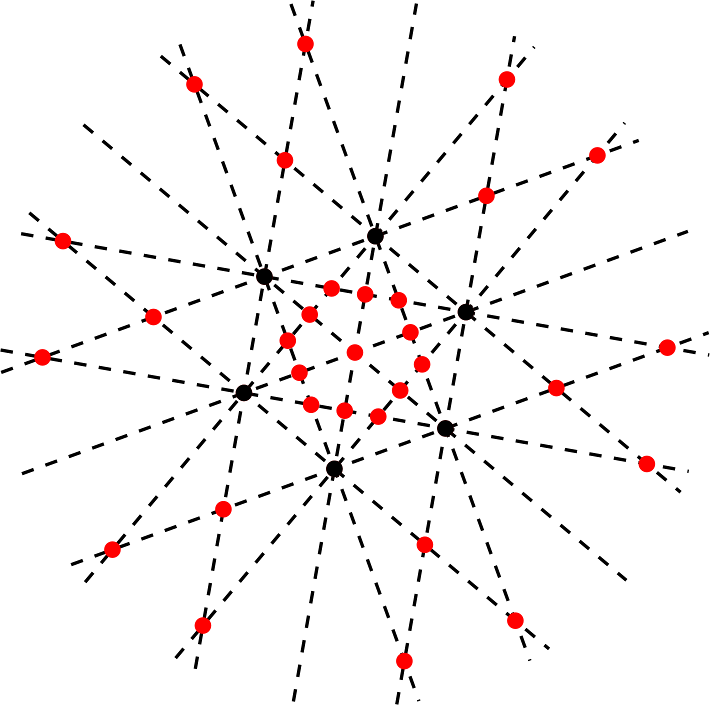• 31 can be written using four 4's:

• Deleting all the even digits from 231 = 2147483648 we obtain a prime (173).
• The lines which pass through pairs of vertices of a regular hexagon (black) meet in further 31 points (red):

31 has 2 divisors, whose sum is σ = 32. Its totient is φ = 30.
The previous prime is 29. The next prime is 37. The reversal of 31 is 13.
It is a happy number.
31 is nontrivially palindromic in base 2 and base 5.
It is a Cunningham number, because it is equal to 25-1.
31 is an esthetic number in base 7, base 9, base 14 and base 15, because in such bases its adjacent digits differ by 1.
It is a weak prime.
31 is a truncatable prime.
It is an emirp because it is prime and its reverse (13) is a distict prime.
It is a cyclic number.
It is not a de Polignac number, because 31 - 21 = 29 is a prime.
It is a super-2 number, since 2×312 = 1922, which contains 22 as substring.
Together with 29, it forms a pair of twin primes.
It is a Chen prime.
It is the 6-th Hogben number.
31 is a lucky number.
31 is a nontrivial repdigit in base 2 and base 5.
It is a plaindrome in base 2, base 4, base 5, base 8, base 9, base 11, base 12, base 13, base 14 and base 16.
It is a nialpdrome in base 2, base 5, base 6, base 7, base 10 and base 15.
It is a zygodrome in base 2 and base 5.
It is a self number, because there is not a number n which added to its sum of digits gives 31.
It is a congruent number.
It is a panconsummate number.
It is a nontrivial repunit in base 2 and in base 5.
It is a pernicious number, because its binary representation contains a prime number (5) of ones.
It is a polite number, since it can be written as a sum of consecutive naturals, namely, 15 + 16.
It is an arithmetic number, because the mean of its divisors is an integer number (16).
31 is the 5-th centered triangular number, the 4-th centered pentagonal number and also the 3-rd centered decagonal number.
31 is a deficient number, since it is larger than the sum of its proper divisors (1).
31 is an equidigital number, since it uses as much as digits as its factorization.
31 is an odious number, because the sum of its binary digits is odd.
The product of its digits is 3, while the sum is 4.
The square root of 31 is about 5.5677643628. The cubic root of 31 is about 3.1413806524.
Adding to 31 its reverse (13), we get a palindrome (44).
The spelling of 31 in words is "thirty-one", and thus it is an aban number and an uban number.
• e-mail: info -at- numbersaplenty.com • Privacy notice • done in 0.070 sec. • engine limits •

